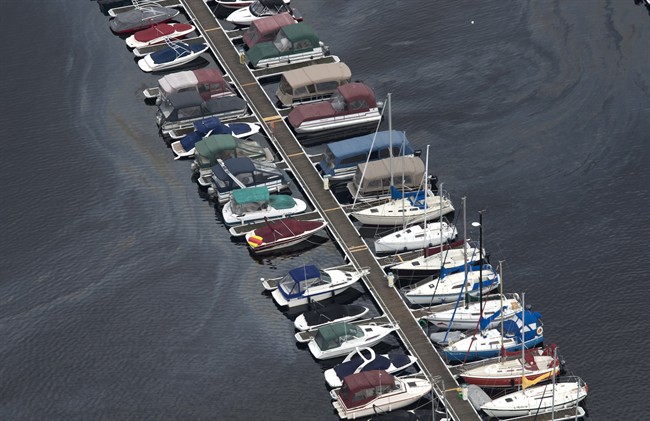CALGARY – Executives with major Canadian pipeline companies say they see no silver lining to the Lac-Megantic train disaster.

There have been suggestions that transporting oil by pipeline may seem more palatable after several oil-laden rail cars exploded over the weekend, killing more than a dozen people and devastating the small Quebec town.
But TransCanada Corp. CEO Russ Girling said there’s “no good news here for anybody” in the tragedy and the notion that the pipeline industry will somehow benefit from it “makes no sense.”
“This is a tragic event that shakes everybody and shakes all of us that are in the business,” he told reporters at the TD Securities Calgary Energy Conference on Tuesday.
While disasters ranging from Lac-Megantic to the massive BP oil spill in the Gulf of Mexico three years ago jolt the public, Girling said companies such as TransCanada still have a responsibility to build new energy infrastructure.
“People continue to have needs for starting their vehicles every morning, cooking their food, heating their homes. We have an obligation to do that as safely as we can.”
The president of Kinder Morgan Canada, which is planning to nearly triple the amount of crude shipped on its Trans Mountain line between Alberta and the B.C. Lower Mainland, said he too fails to see any upside for pipeline firms resulting from Lac-Megantic.
“I think that the public is obviously very concerned about the broad safety net that is available for both rail and pipelines,” said Ian Anderson.
“I think it’s a question of all operators — whether it’s pipe or rail or trucking for that matter — (to) continue to be very diligent and vigilant in their safety precautions.”
Earlier, Girling said he’s “extremely optimistic” the company’s Energy East project — a proposal to ship up to 850,000 barrels a day of Western crude to eastern markets through an underused natural gas line — has enough customer support to go ahead.
Energy East could deliver crude to refineries in Quebec and Saint John, N.B., as well as enable exports to reach markets on the U.S. Eastern Seaboard via tanker.
Quebec Premier Pauline Marois told reporters in Quebec City on Tuesday that it’s “fair to ask the question” of whether construction of projects such as Energy East, and a separate Enbridge Inc. (TSX:ENB) proposal, should be sped up in light of Lac-Megantic.
However, she cautioned she didn’t want to “get the two files mixed up.”
TransCanada’s (TSX:TRP) Keystone XL proposal to connect oilsands crude, along with some U.S. volumes, to Texas refineries has been in limbo for years amid fervent environmental opposition.
Girling says a mid-summer decision by the Obama administration on Keystone XL is looking unlikely and he can’t predict when the protracted regulatory process will finally wrap up.
Rail and pipeline are seen as having two distinct purposes when it comes to transporting crude.
Pipeline is generally seen as the more long-term solution, whereas rail is viewed as a flexible stop-gap measure to tide producers over until the pipelines are built or tap into markets that pipelines can’t access.
With projects such as Keystone XL beset by delays, many companies have been ratcheting up their rail use.
Baytex Energy (TSX:BTE) CEO James Bowzer said he expects about 43 per cent of the company’s heavy oil volumes to move by rail for the remainder of 2013.
Between Alberta and the Bakken region of Saskatchewan and North Dakota, the industry is moving some 750,000 barrels per day of crude by rail, he noted.
John Rogers, vice-president of investor relations at oilsands producer MEG Energy (TSX:MEG), said his company is pursuing pipeline, rail and river barge options to get crude to market.
Of the three, he said pipeline is by far the cheapest at a toll of $10 per barrel between the oilsands region and the Gulf of Mexico. Rail is the priciest at between $15 and $18.
“I think pipelines have always looked better from an economic point of view — they’ve always looked better than rail,” he said.
“I think they both can be used to safely transport crude in North America. They both obviously have challenges that the industry is working real hard to ensure it deals with.”
At the conference, a vice-president at Canadian National Railway Co. (TSX:CNR) touted the benefits of rail over pipelines.
James Cairns, who is in charge of petroleum and chemicals at the railway, said rail holds the solution to one of the oil industry’s biggest challenges — accessing tidewater so that crude can be exported overseas.
While political wrangling over projects such as Keystone XL drags on, CN’s network is able to tap into markets on the West, East and Gulf coasts today, he said.
And while tolls may be higher with rail, Cairns noted that shipping bitumen in heated, insulated railcars negates the need to dilute the thick, sticky crude. That removes the cost of blending the bitumen with lighter products so they can flow in a pipeline.
“We’re sitting on gold here, guys,” said Cairns. “There’s a real opportunity.”
Cairns said he expects to see huge growth in the use of heated, insulated cars in Canada, though so far only one company is using them here.
Cairns said he doesn’t see the Lac-Megantic disaster having an impact on CN’s crude business.
“We’re extremely cautious on how we handle crude and all hazardous products today. So I don’t see how we are going to change how we operate, necessarily. If there’s new legislation or changes that come as a result of this, absolutely we’ll be there to adapt to it,” he said.
“If I look at my crystal ball, I don’t see potential delays coming down the track.”


Comments